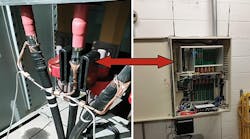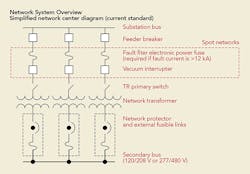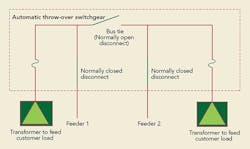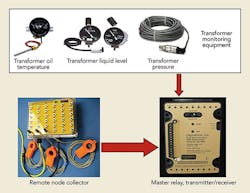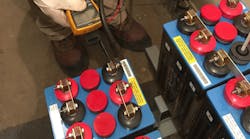Chicago, Illinois, is the dominant metropolis in the Midwest and the third most populous city in the U.S. As such, the City of Chicago has played a central role in American economic, social, cultural and political history since being incorporated as a city in 1837. The continued economic prosperity and well-being of a metropolis like Chicago depends on a reliable electrical infrastructure.
For more than 100 years, Commonwealth Edison (ComEd) has been powering the lives of 3.9 million customers spread across northern Illinois, including Chicago. Like most major cities, Chicago has high-density loads that require highly reliable service. To provide this service, ComEd uses an underground network system. Network systems are reliable because they enable multiple transformers fed from separate primary feeders to be connected in parallel on the secondary side.
Should one of the transformers be de-energized for any reason, a secondary circuit breaker electrically connected to the transformer, called a network protector, will trip open, isolating the transformer from the others to which it is connected. The network protector automatically connects and disconnects a transformer from the secondary network system in response to predetermined electrical conditions controlled by a master relay. Recently, ComEd invested in some network improvements. The utility wanted to take its network protector to the next level with remote monitoring and operation to have more knowledge of and control over its critical operating equipment.
Underground Network Design
Underground network systems are categorized as either grid networks or spot networks. Grid networks have multiple network vaults, called network centers, connected together on the secondary side to provide service to multiple customer loads. The network centers are connected together through secondary cable, also called secondary mains. The secondary mains are typically protected with in-line current limiting fuses. However, in some legacy locations of the Chicago network grid, lead cable is used and current limiting fuses are not required. Spot networks are network centers not tied to other network centers, and all of the customer load is local and served from one vault. The customer load is protected with current limiting fuses.
Both grid and spot network centers offer a high level of redundancy. When one or more transformers in the network center become de-energized, the customer’s load is still served by the other transformers that remain in service.
The Chicago network grid system has been in service since the early 1900s. It consists of 17 independent network groups, with 124 individual dedicated 12-kV feeders from nine separate substations serving only network load. ComEd uses spot network centers to serve customer load, but those feeders are not necessarily dedicated to the network and may serve other radial loads.
ComEd has roughly 2000 network transformers and protectors split between grid and spot network systems along with many miles of secondary mains in the streets of Chicago. The typical secondary voltage from the grid networks is 125/216 V and from the spot networks is 277/480 V.
In addition to network service, primary selective systems also are frequently used by ComEd to supply concentrated loads as an option to certain commercial and industrial customers. Standard service for these customers fed from the 12-kV system consists of a normal service line and an emergency line with a manually switched tie point between them. However, for customers choosing to upgrade from a standard service to a primary selective system, an automatic throw-over (ATO) is used instead of a manual switch.
An ATO is a type of switchgear that has two individual feeders as its source and may have an open tie switch between them. If one source becomes de-energized or voltage has been reduced below a predetermined level for a period of time sufficient to confirm the loss is not transient, the controller that operates the disconnects will open the normally closed disconnect with the de-energized feeder, and it will close the normally open disconnect to transfer the load to the other energized feeder. The timing of the transfer is predetermined with standard ComEd settings to coordinate with station circuit breakers.
ATO switchgears are typically located within customer facilities and enable fast restoration times; however, a brief interruption of service will occur while power is transferred from one source to the other. ComEd has roughly 1300 ATO switchgears servicing commercial and industrial customers.
The Case for Monitoring
ComEd performs periodic maintenance, comprising of both visual inspections and equipment operation, on network protectors and ATO switchgears to mitigate the risks of outages and other equipment issues. However, if an abnormal condition occurs between maintenance periods, it will not be detected until either an outage happens or the next maintenance cycle occurs. The only way to know what the condition of the equipment is at any given point in time is to install remote monitoring.
Remote monitoring of utility equipment is not a new concept. Typical communications methods are fiber optics, 900-MHz radio, cellular and power line carrier (PLC). Fiber-optic communications is not always cost effective and — because most of the locations of the network transformers and ATO switchgears are in the downtown area of Chicago, both in buildings and underground — radio and cellular communications are challenging.
To overcome these communications challenges, ComEd established a cross-functional team to collaboratively investigate a remote monitoring system using PLC technology from Digitalgrid Inc. PLC is a communications medium that transmits a carrier signal from the equipment being monitored through the energized cables to a receiver located at the source substation.
Proof of Concept
For ComEd, two key elements of installing a monitoring system on a network transformer are the ease of installation and minimal amount of components needed. Digitalgrid is able to meet both these needs with its network protector master relay. The master relay is what controls the network protector, but the company has been able to economize space and functionality by giving its master relay a dual purpose — protector controller and transceiver.
Network transformers are typically installed in vaults where internal work space is minimal; therefore, if a catastrophic equipment failure occurs, employee safety may be at risk. For this reason, ComEd decided to monitor the network protector as well as its associated transformer. Digitalgrid is not specialized in transformer monitoring, so Qualitrol was engaged to fill this monitoring void.
Another critical component of ComEd’s network grid is the secondary mains. Although the redundancy of parallel service is highly reliable, cascading effects can happen when the cables begin to fail. Unfortunately, the only way to know when cables are failing is by either a customer outage or low voltage. Digitalgrid has provided a remote node collector to monitor secondary load and to identify a faulted cable, which will provide ComEd a chance to respond proactively in a controlled manner instead of reactively during an emergency.
In addition to network equipment, ATOs are a critical piece of infrastructure related to customer satisfaction and a reduction in the customer average interruption duration index (CAIDI).Therefore, having the ability to monitor them is advantageous. Because ATOs use their own controller, unique to the manufacturer, the network protector master relay is not an option.
Digitalgrid offered a one-way transmitter to capture the equipment status points and provide monitoring capability using the same communications system as the networks. While monitoring of network components is not a new concept, this was the first time PLC technology would be used to monitor the status of ATO switchgears.
Transmitting all this critical data was only half the story; there needed to be a way to receive it and to make it available to ComEd operating and engineering departments. To achieve this, Digitalgrid supplied sensor coils mounted to the primary feeder cables, associated with the ATO and network relay transmitters, at the substation circuit breaker cubicles. The sensor coils would process the transmitted signals and pass them on to the network communications system (NCS) receiver at the substation. The NCS receiver would demodulate, process and distribute the data to a remote server. The NCS also would transmit command signals to the network protectors for safe, remote equipment operation.
During the proof of concept, data was linked to Digitalgrid’s web portal service and would be accessible by ComEd. If this technology is selected for full deployment, data will be stored in ComEd’s supervisory control and data acquisition (SCADA) system.
The Benefits
ComEd completed installation of a monitoring system at Midway International Airport in 2015 and installation on a portion of the network grid in the first quarter of 2016. Overall, the monitoring system will give ComEd control over the network system and the ability to capture real-time data on the following:
- Network protector status
- Transformer secondary current and voltage levels
- Liquid in the protector housing
- Transformer status (oil level and pressure for the main tank and primary switch compartment)
- Transformer status (main tank oil temperature)
- Transformer status (hydrogen in main tank and primary switch compartment)
- Load readings of the secondary grid
- Vault temperature
- Vault flooding alarms
- Vacuum switch status, where available
- Protector cycles
- ATO switchgear status, including switch position, source availability, auto/manual and ready to transfer.
Besides the benefit of having knowledge of and control over critical operating equipment, this information adds a tremendous safety factor for operating personnel. Not only can the network protector be operated remotely with no one in the vault, but now informed decisions can be made to determine reaction to vault and loading conditions, which has never before been possible on the ComEd system.
This type of grid intelligence not only provides a safer work environment for ComEd’s employees, but it also has the ability to save important utility assets as well as improve customer reliability and satisfaction by preventing potential outages. Building communications systems with the ability to monitor and control existing electrical system components such as network protectors and ATOs leads to a smarter grid on the ComEd system.
Peter Tyschenko is manager of capacity planning at Commonwealth Edison in Illinois, U.S. He received a BSEE degree from the University of Illinois at Chicago and joined ComEd after graduation. He has been involved in a broad range of activities, including field engineering, work management, reliability programs and engineering standards.
Edward Smykowski is a senior engineer in distribution standards at Commonwealth Edison in Illinois, U.S. He received a BSEET degree from DeVry University. He has been involved in a broad range of activities, including field testing and commissioning of network system components.
Glenn Gilliam is manager of the network high-rise group at Commonwealth Edison in Illinois, U.S. He received his undergraduate degree in electrical instrumentation and controls/electrical construction in the College of Technology at the State University of New York at Delhi. He is responsible for the installation and maintenance of vault and network equipment.
